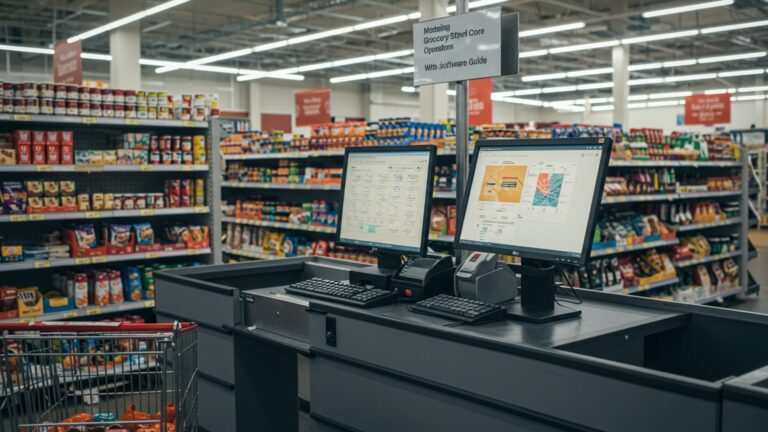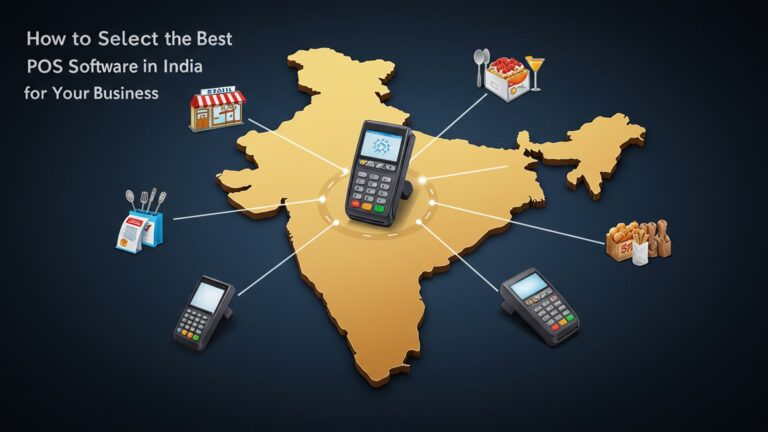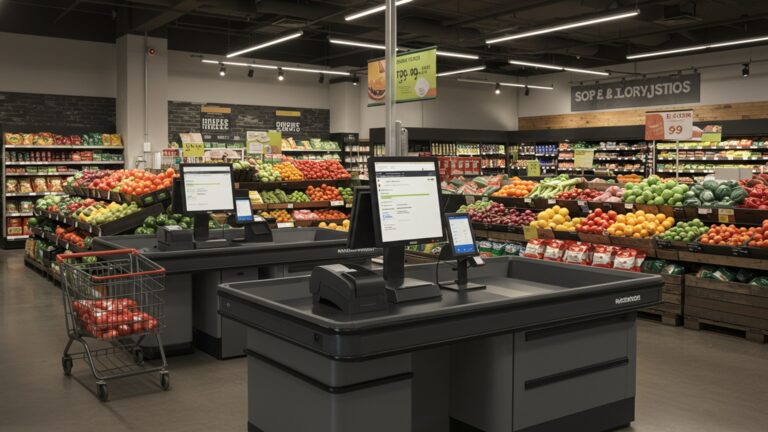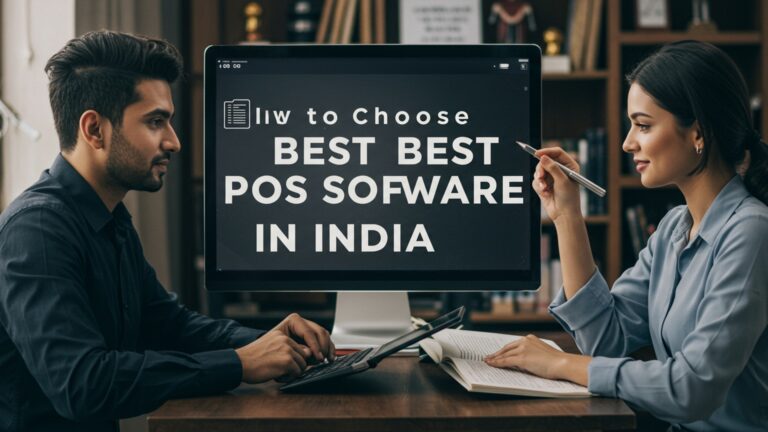How to Select the Best POS Software in India for Your Business
In India’s rapidly evolving retail and hospitality landscape, businesses face intense pressure to optimize operations and enhance customer experience. Merely processing transactions is no longer sufficient; a robust Point-of-Sale (POS) system must serve as the central nervous system for growth. With the proliferation of cloud-native solutions, AI-driven analytics. the necessity for seamless UPI integration, selecting the best POS software in India demands meticulous evaluation. Forward-thinking enterprises, from multi-chain restaurants leveraging ONDC compatibility to fashion boutiques integrating online and offline inventory, recognize that the right POS drives not just efficiency. scalable success in a competitive market.

Understanding the Core of POS Software
At its heart, Point of Sale (POS) software is the digital backbone of any retail or service business, orchestrating transactions and streamlining operations. It’s far more than just a cash register; it’s an integrated system that manages sales, inventory, customer data. sometimes even employee performance. For businesses in India, where the market is diverse and dynamic, a robust POS system is no longer a luxury but a necessity for growth and efficiency.
Think of it this way: when a customer makes a purchase, the POS software instantly records the sale, updates inventory levels, processes the payment. often captures customer insights for loyalty programs. This integrated approach replaces manual, error-prone processes, making operations smoother and data more reliable.
Why POS Software is Indispensable for Indian Businesses
In India’s competitive landscape, businesses face unique challenges and opportunities. A well-chosen POS system can be a game-changer:
- Enhanced Efficiency: Automates routine tasks like sales processing, inventory updates. reporting, freeing up staff to focus on customer service.
- Improved Accuracy: Minimizes human errors in pricing, inventory counting. financial reconciliation.
- Better Inventory Management: Provides real-time insights into stock levels, helps identify fast-moving and slow-moving items. aids in reorder decisions, reducing wastage and stockouts.
- Customer Relationship Management (CRM): Many modern POS systems track customer purchase history, preferences. loyalty points, enabling personalized marketing and better service.
- Data-Driven Decisions: Generates comprehensive reports on sales trends, employee performance. peak hours, empowering owners to make informed strategic decisions.
- Compliance with Indian Regulations: Especially crucial for Goods and Services Tax (GST) compliance, as many POS systems offer integrated GST invoicing and reporting features. This is a key factor when looking for the best pos software in India.
Key Features to Look for in the Best POS Software in India
When you’re evaluating options, the feature set is paramount. Here’s a breakdown of what to prioritize:
- Sales and Transaction Processing:
- Quick and intuitive interface for sales.
- Support for various payment methods (cash, credit/debit cards, UPI, mobile wallets like PayTM, Google Pay, etc.) .
- Ability to apply discounts, promotions. loyalty points.
- Customizable receipts (print/email).
- Easy returns, exchanges. refunds.
- Inventory Management:
- Real-time stock tracking across multiple locations.
- Automated reorder points and alerts.
- Barcode scanning capabilities.
- Ability to manage product variations (size, color, etc.) .
- Inventory reporting and analysis.
- Customer Management (CRM):
- Customer database with purchase history.
- Loyalty program management.
- Ability to send SMS/email marketing campaigns.
- Employee Management:
- User permissions and access control.
- Time clock for tracking shifts.
- Sales performance tracking for individual employees.
- Reporting and Analytics:
- Comprehensive sales reports (daily, weekly, monthly, yearly).
- Product performance reports.
- Employee performance reports.
- Tax reports (especially GST reports for India).
- Customizable dashboards.
- Hardware Compatibility:
- Ensure compatibility with essential hardware like barcode scanners, receipt printers, cash drawers. card readers.
- Consider if it supports mobile POS devices for on-the-go sales.
Cloud-Based vs. On-Premise POS: A Comparison
The fundamental choice often boils down to how the software is hosted and accessed. Each has distinct advantages and disadvantages, particularly relevant for Indian businesses.
| Feature | Cloud-Based POS (SaaS) | On-Premise POS |
|---|---|---|
| Hosting | Hosted on vendor’s servers, accessed via internet browser or app. | Installed and run on your local computers/servers. |
| Cost | Subscription-based (monthly/annual fees). Lower upfront cost. | Higher upfront cost for software license and hardware. Lower recurring fees. |
| Accessibility | Accessible from anywhere with an internet connection (mobile, tablet, desktop). | Primarily accessible within the physical business location. Remote access requires additional setup. |
| Updates & Maintenance | Vendor handles updates, security patches. maintenance automatically. | Requires your IT staff or third-party vendor for updates and maintenance. |
| Data Security | Relies on vendor’s robust security measures. Data often backed up automatically off-site. | Your responsibility to manage backups and security. Vulnerable to local hardware failures. |
| Scalability | Easily scalable by adjusting subscription plans, adding users/locations. | Scaling may require significant hardware upgrades and additional licenses. |
| Offline Capability | Some offer limited offline mode, syncing data when connectivity returns. Full functionality requires internet. | Generally works fully offline, as data is stored locally. |
| Customization | Limited customization options, usually through configurations provided by the vendor. | More extensive customization possible. often at a higher cost and complexity. |
For many small to medium-sized businesses (SMBs) in India, cloud-based solutions are increasingly popular due to their flexibility, lower upfront cost. ease of maintenance, making them strong contenders for the best pos software in India.
Industry-Specific POS Needs and Real-World Applications
Not all businesses are created equal. neither are their POS requirements. The best pos software in India will often cater to specific industry verticals:
- Retail (Fashion, Electronics, Groceries): Needs robust inventory management, barcode scanning, loyalty programs. seasonal sales handling. A fashion boutique might prioritize detailed size/color matrix, while a grocery store needs quick billing and weight-based pricing.
- Restaurants and Cafes: Requires table management, kitchen order ticketing (KOT), menu customization, ingredient tracking, split billing. integration with online food delivery platforms (e. g. , Zomato, Swiggy).
- Salons and Spas: Focuses on appointment scheduling, service booking, staff management (commissions), client history. package deals.
- Pharmacies: Needs precise inventory control for medicines (batch numbers, expiry dates), doctor prescription management. regulatory compliance for controlled substances.
- Small Shops and Kirana Stores: Often look for simple, affordable. easy-to-use systems that can handle cash, UPI payments. basic inventory with minimal training.
For example, a boutique owner in Delhi using a specialized retail POS system can track which styles are selling best, manage inventory across multiple outlets. offer personalized discounts to loyal customers based on their purchase history, all through a single dashboard. This level of detail is crucial for competitive advantage.
Integration Capabilities: Connecting Your Business Ecosystem
A truly powerful POS system doesn’t operate in a silo. Its ability to integrate with other business tools is critical for a seamless operation. When searching for the best pos software in India, consider these integrations:
- Payment Gateways: Essential for processing digital payments securely. Look for integration with popular Indian payment gateways and mobile wallets (e. g. , Razorpay, PayU, Stripe, PayTM, Google Pay).
- Accounting Software: Integrates sales data directly into your accounting platform (e. g. , Tally, Zoho Books, QuickBooks), simplifying reconciliation and tax filing, especially GST. This reduces manual data entry and errors.
- E-commerce Platforms: For businesses with an online presence, integration with platforms like Shopify, WooCommerce, or Magento ensures inventory is synchronized across online and offline channels, preventing overselling or stock discrepancies.
- CRM Systems: Deeper CRM integration can enhance customer profiling and targeted marketing efforts beyond basic loyalty programs.
- Third-Party Apps: Some POS systems offer an app marketplace or APIs for connecting with specialized tools like HR software, marketing automation platforms, or delivery services.
Imagine a scenario where a retail store in Bangalore integrates its POS with its e-commerce website. A customer buys a product online. the POS automatically updates the in-store inventory, ensuring real-time stock accuracy for both channels. This creates an omnichannel experience that customers expect today.
Scalability and Future-Proofing Your Investment
Your business will grow. your POS system should be able to grow with it. Investing in a scalable solution means you won’t outgrow it within a few years, incurring additional costs and disruption from switching systems.
- Multiple Locations: Can the software easily manage inventory, sales. reporting across several stores or branches?
- Increased Transaction Volume: Can it handle a higher number of transactions without slowing down or crashing during peak seasons?
- New Features: Does the vendor regularly release updates and new features to keep pace with technological advancements and market demands?
- User Management: Can you easily add or remove users as your staff expands or changes?
For a startup planning aggressive expansion, choosing a POS that can seamlessly add new stores and manage a growing product catalog without performance degradation is vital. This foresight makes the selected system truly the best pos software in India for their long-term vision.
Vendor Support and Training: A Critical Factor
Even the most intuitive software can present challenges. Reliable customer support and comprehensive training are non-negotiable, especially in India where diverse languages and regional nuances can play a role.
- Availability: Look for 24/7 or extensive business hour support. What channels are available (phone, email, chat, remote access)?
- Local Presence: Does the vendor have a local support team or partners in India who comprehend the specific business environment and regulations?
- Training: What kind of training is offered (online tutorials, in-person sessions, documentation)? Is it easy to comprehend for all staff levels?
- Reputation: Check online reviews, testimonials. industry forums for feedback on the vendor’s support quality.
A real-world example: A restaurant owner in Chennai encountered an issue with payment processing during a busy lunch rush. Having access to a responsive, local support team that could quickly diagnose and resolve the issue prevented significant customer dissatisfaction and potential loss of revenue. This level of service differentiates good software from the best pos software in India.
Cost Considerations: Beyond the Sticker Price
While the initial cost is crucial, it’s crucial to look at the total cost of ownership (TCO) to avoid hidden expenses.
- Software Licensing/Subscription Fees: Monthly or annual fees. grasp what features are included in each tier.
- Hardware Costs: POS terminals, printers, scanners, cash drawers. Some vendors offer bundles.
- Installation and Setup Fees: For getting the system up and running.
- Training Costs: If not included in the package.
- Support and Maintenance Fees: Ongoing costs for technical assistance and updates.
- Payment Processing Fees: Transaction fees charged by payment gateways.
- Integration Fees: Costs associated with connecting to other software.
It’s wise to ask for a detailed breakdown of all potential costs. Some vendors might offer a low upfront fee but charge hefty amounts for essential integrations or advanced features. Always get a clear quote and grasp the pricing structure to determine if it truly offers value for money.
Legal and Regulatory Compliance in India
Operating a business in India means adhering to specific laws and regulations. Your POS software must support these to avoid penalties.
- GST Compliance: The software should be capable of generating GST-compliant invoices, maintaining records for different tax slabs. producing reports necessary for GST filing. This is a non-negotiable feature for any best pos software in India.
- Data Privacy: While India’s data protection laws are evolving, ensure the software vendor adheres to best practices for securing customer and transaction data. interpret where your data is stored (especially for cloud-based solutions) and how it’s protected.
- E-invoicing: For businesses exceeding certain turnover thresholds, e-invoicing is mandatory. Check if the POS system supports or can integrate with e-invoicing solutions.
A business that fails to generate proper GST invoices or maintain accurate tax records due to inadequate POS software can face significant fines and audits. A reliable POS system acts as your first line of defense against such compliance issues.
Steps to Evaluate and Select the Best POS Software
Follow a structured approach to ensure you make the right choice:
- Assess Your Business Needs:
- What are your core business processes?
- What specific problems do you need the POS to solve (e. g. , slow checkout, inventory inaccuracies, poor customer data)?
- What is your budget (upfront and recurring)?
- How many locations and users do you have?
- Research and Shortlist Vendors:
- Look for vendors that specialize in your industry or have a strong presence in India.
- Read reviews, case studies. compare features.
- Ask for recommendations from other business owners.
- Request Demos and Free Trials:
- Hands-on experience is invaluable. Test the software with your actual products and scenarios.
- Involve your staff in the demo process to get their feedback on usability.
- Check Integration Capabilities:
- Confirm compatibility with your existing accounting software, payment gateways. e-commerce platforms.
- Evaluate Support and Training:
- Contact their support team with a few questions to gauge their responsiveness and helpfulness.
- comprehend the training resources available.
- Review Contracts and Pricing:
- Get a detailed quote covering all costs.
- interpret terms and conditions, cancellation policies. data ownership.
- Make a Decision:
- Based on your evaluation, choose the system that best aligns with your business needs, budget. long-term goals.
A small apparel store owner in Jaipur might begin by listing their pain points: slow manual billing, incorrect inventory counts. no customer loyalty program. They would then seek out a POS system known for its retail-specific features, try out a few demos. finally select one that not only solves these problems but also offers robust local support and GST compliance, solidifying it as the best pos software in India for their specific needs.
Common Pitfalls to Avoid When Selecting POS Software
Navigating the POS market can be tricky. Be aware of these common mistakes:
- Underestimating Your Needs: Choosing a basic system only to realize it lacks essential features as your business grows.
- Ignoring Scalability: Opting for a system that can’t handle future expansion (more stores, higher transaction volume).
- Overlooking Hidden Costs: Focusing only on the subscription fee and neglecting hardware, setup, training, or integration costs.
- Poor Integration: Selecting a standalone system that doesn’t integrate with your other crucial business software, leading to manual data entry and inefficiencies.
- Neglecting Support: Choosing a vendor with poor or inaccessible customer support, which can be disastrous when issues arise.
- Skipping Demos/Trials: Not getting hands-on experience with the software before committing, leading to usability issues later.
- Ignoring Local Compliance: Picking a system that isn’t fully compliant with Indian tax regulations (e. g. , GST).
By being mindful of these pitfalls, Indian businesses can make a more informed and effective decision in their quest for the best pos software in India.
Conclusion
Selecting the ideal POS software for your Indian business is far more than a mere transaction; it’s a strategic decision that shapes your operational efficiency and growth trajectory. We’ve explored the critical factors, from robust inventory management to seamless UPI integration, which are non-negotiable in today’s dynamic market. My personal tip, based on observing countless businesses, is to prioritise local support and scalability over initial cost; a system that grows with you and offers immediate assistance during peak hours, perhaps even supporting regional languages for your staff, truly pays dividends. Embrace this newfound understanding, conduct thorough demos. don’t hesitate to ask specific questions about GST compliance or how it handles the unique challenges of Indian payment gateways. Your chosen POS isn’t just software; it’s a silent partner, ready to streamline your sales, refine your inventory. ultimately, elevate your customer experience. Take this actionable insight, apply it diligently. empower your business to thrive in India’s competitive landscape.
More Articles
How to Master Billing and POS Software for Efficient Retail Management
Learn 8 Smart Inventory Control Strategies Using POS in India
How to Streamline Billing and POS Software for Efficient Sales and Inventory Management
Learn 9 Practical Strategies to Streamline Billing Process and Boost Business Efficiency
7 Essential Inventory Management POS Tips for Indian Businesses
FAQs
Why bother with POS software for my Indian business?
It’s super helpful! A good POS system streamlines your sales, manages inventory, tracks customer data. even helps with staff management. For businesses in India, it means faster checkouts, better inventory control. insights to grow your business, all while keeping a digital record of transactions.
What key features should I absolutely look for in a POS system for India?
Definitely prioritize inventory management, sales tracking, customer relationship management (CRM), employee management. robust reporting. For India specifically, ensure it handles GST compliance, multiple payment options (like UPI, cards, cash). potentially multi-store management if you’re growing.
How critical is GST compliance for POS software in India?
It’s extremely critical. Your POS software must be GST-compliant, meaning it can accurately calculate and apply GST rates, generate GST-ready invoices. provide reports that simplify your tax filings. Skipping this can lead to compliance issues and penalties.
Should I choose a cloud-based or traditional on-premise POS system?
Cloud-based POS is generally more popular now. It’s accessible from anywhere, updates automatically. often has lower upfront costs. On-premise gives you more control over data but requires your own hardware and IT maintenance. For most Indian businesses, cloud offers greater flexibility and scalability.
What about integrating the POS with other tools I use?
Integration is a game-changer! Look for software that can easily connect with your accounting software (like Tally), e-commerce platforms, payment gateways. loyalty programs. This avoids manual data entry, reduces errors. gives you a holistic view of your business operations.
What’s the typical cost range for POS software in India?
Costs vary quite a bit. You might find basic cloud-based solutions starting from a few hundred rupees per month, going up to several thousands for more advanced, feature-rich systems or custom on-premise solutions. It often depends on the number of users, features. transactions. Always check for transparent pricing and any hidden fees.
How essential is local support and training from the vendor?
Very essential! Good local support means you can get help quickly if something goes wrong. training ensures you and your staff can use the system effectively from day one. Look for vendors offering phone, email, chat support. ideally on-site assistance or comprehensive online resources in India.






